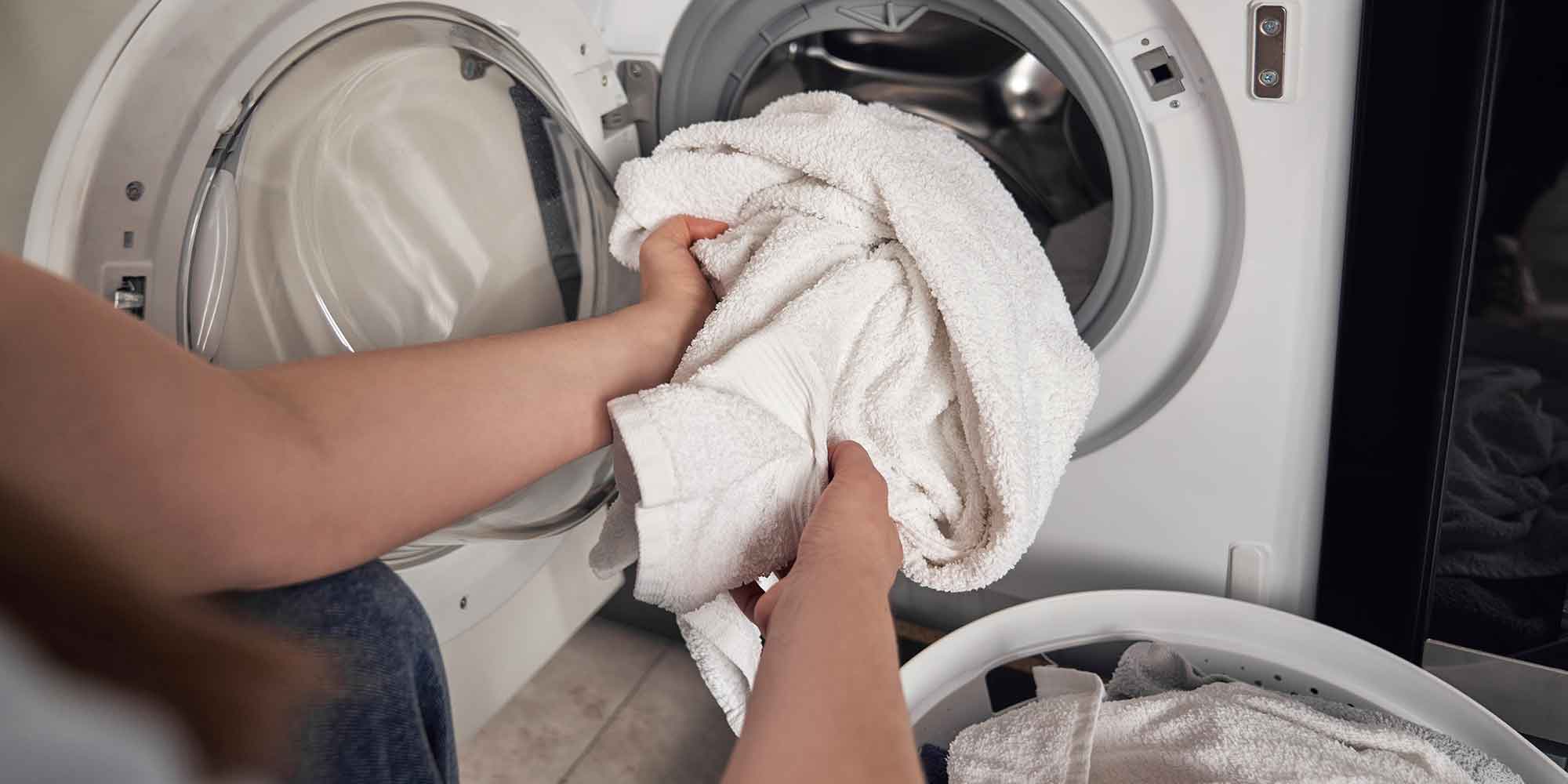By clicking a retailer link you consent to third-party cookies that track your onward journey. This enables W? to receive an affiliate commission if you make a purchase, which supports our mission to be the UK's consumer champion.
Washing machine temperature guide

Many of us wash the bulk of our clothes at 40°C. But cooler or hotter temperatures may be best for some items.
Our washing machine temperature guide will help you to decide which temperature is best for jeans, whites, colours, baby clothes and more.
Head to our washing machine reviews to discover which models impressed in our rigorous tests.
Washing machine temperatures 101
What temperature is a cold wash? Generally, any cycle that doesn't involve the water being heated (aka, around 20°C) is considered a cold wash.
What temperature is a hot wash? The most common temperature for a hot wash is 60°C, whereas 90°C is classed as very hot.
What temperature is a warm wash? 40°C will feel warm and, with some exceptions, most laundry will end up being washed at 40°C.
Which temperature is best for killing germs? Ideally, you need to be washing items at 60°C with a good quality detergent to effectively remove germs and other nasties.
Which temperature is best for banishing stains? Washing at 40°C should do the job for most stains, but serious soiling might need a blast at 60°C.
Can I wash clothes at 20°C?

Yes, you can wash clothes at 20°C - it's an excellent energy-saving option.
It's best for lightly soiled clothing though. Heavily stained items usually benefit from being washed at a higher temperature.
Benefits of washing at 20°C
- It's eco-friendly: Our tests found that turning the temperature down on the cottons program from 40°C to 20°C reduced running costs by an average of 62%. This is because washing machines need to use less energy to heat water to lower temperatures.
- It's good for delicates: A cold wash is well-suited to washing delicates such as lace, wool and silk, as it's less likely to damage the fibres.
Drawbacks of washing at 20°C
- Cleaning power: Our tests also found that cleaning power was slightly worse at 20°C but switching to a liquid detergent helped, and it should still be enough for everyday cleaning.
- Maintenance cycles: If you wash at low temperatures, it becomes even more important to run a regular monthly maintenance wash with a washing machine cleaner.
If you’re keeping a close eye on your energy bills, check out the most energy-efficient washing machines according to our tests
Washing at 30°C

30°C is a regularly used cycle for many people, and a good, eco-friendly, everyday wash.
Is 30°C a cold wash?
No, 30°C is not a true cold wash. While a cold wash shouldn't involve any heating of the water at all, 20°C is generally considered a cold wash.
Benefits of washing at 30°C
- It's eco-friendly: Washing at 30°C uses 38% less energy than washing at 40°C, so you make a substantial saving on your bill and help the planet.
- It's good for delicates: It's the recommended setting for a lot of delicate clothes, such as wool and silk. Always check the label, though.
- It protects brightly coloured fabrics: Lower temperatures are also good at helping preserve colourfully dyed fabrics and a good-quality laundry detergent can help with this, too.
Drawbacks of washing at 30°C
- It won't shift tough stains: For the most effective stain removal, you're better off using one of the 40°C programs on your machine.
- It's not effective at killing bacteria: To ensure you banish bacteria from your items, you need to be washing at 60°C or higher with a good detergent.
Take a look at our best and worst laundry detergents to see which brands came out on top in our testing
Washing at 40°C

Lower temperatures will be fine for everyday cleaning, but a 40°C wash will be better for tougher stains.
We base our own testing on the 40°C cottons and synthetics wash programs because that’s what our surveys have found that real people use most of the time.
Benefits of washing at 40°C
- Cleaning quality: In our tests, a washing machine that scores five stars for cleaning removes 30% more stains than a one-star model on a 40°C washing cycle.
- It's the recommended temperature for many items, such as cotton, linen, viscose or acrylics. Always check the label first, though.
Drawbacks of washing at 40°C
- Less energy-efficient than washing at 30°C: Unsurprisingly, the price you pay for improved stain removal is increased energy use, and therefore higher running costs.
- Could damage delicates: There's no guarantee that delicate items will survive at 40°C as they're designed to be washed at cooler temperatures.
- Might fade colours: For the best chance at maintaining bright, vibrant colours opt for a 30°C cycle instead.
Our guide on useful washing machine cycles reveals which programs are genuinely helpful and which aren't worth the hype.
Washing at 50°C
A 50°C wash is suitable for polyester/cotton mixtures, nylon, cotton and viscose.
However, most stains will be shifted at 40°C and increasing the temperature will consume more energy, so there's no good reason to switch to 50°C.
Washing at 60°C

Think of 60°C as a hot wash. Washing at 60°C generally cleans slightly better than the 40°C program, especially on greasy stains. However, running costs increase by more than half.
Benefits of washing at 60°C
- Good for greasy stains: The higher temperature is better at breaking down grease, especially from lighter items where stains seem to cling much more stubbornly.
- Ideal for bedding and lighter-coloured towels: These items get a lot of heavy use, so a hot wash helps to keep them in their best condition for as long as possible. In most cases, you're best off washing towels at 40°C, but if your towels are white or light in colour, a 60°C wash might help to keep them from developing that unsightly grey tinge.
Drawbacks of washing at 60°C
- Could shrink some fabrics: Not all items are designed to tolerate a hot wash, so you can't just throw everything into the drum and expect it to emerge looking the same as before.
- Won't eliminate all germs solo: Some bacterial spores and viruses are resistant to 60°C washes, so without an effective detergent they won't be removed from your fabrics.
From washing machines to tumble dryers and fridge freezers, find out how much your appliances cost to run
Washing at 90°C
Think of 90°C as a very hot wash.
It's the hottest wash program you’ll find on most machines and is only suitable for a few items, as many labels won't recommend washing at such a high temperature.
Will washing at 90°C kill bacteria?
The NHS website states that you should wash underwear, towels and household linen at 60°C to prevent the spread of germs, or at 40°C with a bleach-based laundry product (we suggest bio washing powder). It says nothing about washing at as high as 90°C to kill bacteria.
And while washing at such a high temperature should certainly help to banish stains, only use it when the fabric is robust enough to stand up to the heat. Always check the label.
A good washing machine paired with a powerful detergent should tackle stains without the need for a boil wash. Discover the best washing machines and best laundry detergents according to our tests.
What to wash at which temperature: item-specific advice
What temperature should I wash denim jeans at?

Denim can shrink and colours will fade, so to avoid shrinkage and to keep your blue jeans blue, don’t wash them at higher than 40°C. It's especially important to use a cold setting when cleaning stretchy jeans.
If your washing machine has a specialist jeans program – and you have the time to split and separate your wash – it will use more water to flush away detergent and spins more gently to avoid creasing.
You should always air dry your jeans, preferably out of direct sunlight, as they don't belong in a tumble dryer.
What temperature should I wash white clothes at?
Separating whites from coloured clothes is more important than the temperature you wash them at. If you separate them, you give yourself the best chance of avoiding colours from other clothes bleeding into them.
The temperature you wash at will depend on how robust the items are - and how dirty.
If you’re washing white bed sheets and other linen, 60°C will be fine. If you have a filthy white rugby or a football kit stained with mud, blood, grass and everything else a Saturday morning on the playing fields has to offer, similarly opt for a higher temperature.
What temperature should I wash mixed coloured clothes at?
Washing a mixture of bright colours together is fine and only becomes a problem if any whites end up in the load. 30°C would be a good temperature to wash and this will help the fabrics to retain their colour.
What temperature should I wash baby clothes at?

Aim for a 30°C or 40°C wash program for baby clothes. Any hotter and you risk shrinking what can be quite delicate clothes.
You can wash your baby’s clothes with the rest of your laundry, or try the baby program if your machine has that option. This will be a little hotter, but rinses more thoroughly – more so than a normal wash setting – to make sure as much detergent as possible has been rinsed away.
If your machine doesn't have a baby setting, simply run the rinse cycle an extra time for a similar effect.
What temperature should I wash underwear at?
If you end up with a pile of pants to wash, set your machine to wash at 60°C for the best results. If your load is very heavily soiled, wash at the highest temperature, which is 90°C on most machines.
Find more expert advice on nailing the laundry, read how to wash clothes
What temperature should I wash bed sheets at?

Select the 60°C cottons program for cotton bed sheets. By washing bed linen, such as sheets, pillowcases and duvet covers at 60°C – and by using the best laundry detergent – you give yourself a better chance of getting them clean without using the highest temperature setting.
Find out how often you should wash your bedding to keep it free from dirt, dust mites, dead skin cells and sweat
What temperature should I wash towels at?
You might think that hotter is better for towels, but that's not necessarily the case. Many people think that 60°C is ideal, but considering some bacterial spores and viruses are resistant to even these temperatures, it could actually end up just being a waste of energy.
In most cases, you're best off washing towels at 40°C and using a bio washing powder (or other bleach-based laundry product) to remove all of the nasties lurking in the fabric. If your towels are white or light in colour, a 60°C wash might help to keep them from developing that unsightly grey tinge, though.
Head to our guide on how to get fluffy towels for more tips on keeping your towels looking and feeling their best
